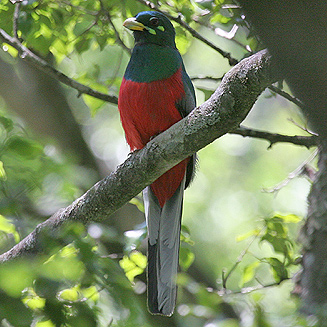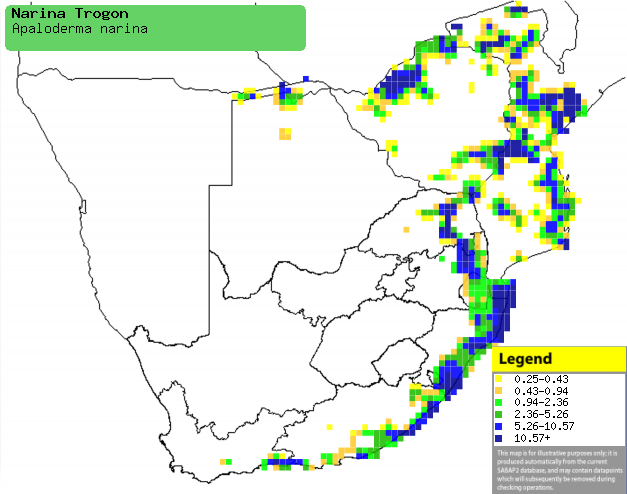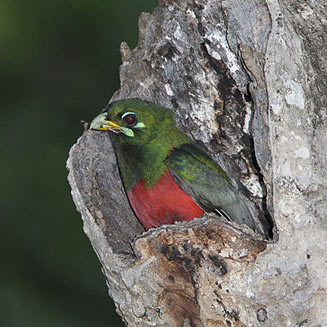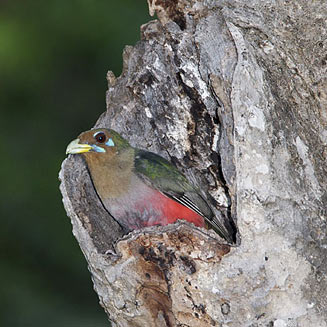|
Apaloderma narina (Narina
trogon)
Bosloerie [Afrikaans]; Intshatshongo [Xhosa]; Narina-trogon
[Dutch]; Trogon narina [French]; Narina-trogon, Zügeltrogon [German];
Republicano [Portuguese]
Life
> Eukaryotes >
Opisthokonta
> Metazoa (animals) >
Bilateria >
Deuterostomia > Chordata >
Craniata > Vertebrata (vertebrates) > Gnathostomata (jawed
vertebrates) > Teleostomi (teleost fish) > Osteichthyes (bony fish) > Class:
Sarcopterygii (lobe-finned
fish) > Stegocephalia (terrestrial
vertebrates) > Tetrapoda
(four-legged vertebrates) > Reptiliomorpha > Amniota >
Reptilia (reptiles) >
Romeriida > Diapsida > Archosauromorpha > Archosauria >
Dinosauria
(dinosaurs) > Saurischia > Theropoda (bipedal predatory dinosaurs) >
Coelurosauria > Maniraptora > Aves
(birds) > Order: Trogoniformes > Family: Trogonidae
 |
 |
|
Narina Trogon male on perch. It can perch while
completely motionless for up to 30 minutes! [photo
Stephen Davis
©] |
Narina trogon male. [photo
Hugh Chittenden ©] |
The Narina trogon occurs in Africa south of the Sahel,
from Ghana to Ethiopia, extending south to Angola and southern Africa, where it
prefers to live in indigenous forest. It feeds mainly on invertebrates, such as
caterpillars,
spiders and mantids, rarely feeding on small reptiles. It nests in
natural tree cavities, which are notoriously difficult to find. It lays 2-4
eggs, which are incubated by both sexes, for 16-21 days. The chicks are brooded
in the early stages of their life, staying the nest for 25-28 days. They remain
with the parents months after fledging, even when they can get their own food.
Distribution and habitat
Occurs across much of sub-Saharan Africa; within southern Africa
it is locally common in the Caprivi Strip (Namibia), northern Botswana,
Zimbabwe, Mozambique and eastern and southern South Africa. It generally prefers evergreen
lowland and afromontane forest, as well as riverine forest in savanna, with trees such
as Acacia, Mopane
(Colophospermum mopane), Zambezi teak (Baikiaea plurijuga), Lebombo-ironwood
(Androstachys johnsonii) and alien
Eucalyptus trees.
|
 |
|
Distribution of Narina trogon in southern Africa,
based on statistical smoothing of the records from first SA Bird Atlas
Project (©
Animal Demography unit, University of
Cape Town; smoothing by Birgit Erni and Francesca Little). Colours range
from dark blue (most common) through to yellow (least common).
See here for the latest distribution
from the SABAP2. |
Call
Food
It feeds mainly on invertebrates, such as
caterpillars,
spiders and mantids,
rarely supplemented with small reptiles. It hunts by sitting motionlessly on a
perch, occasionally moving its head side to side and up and down, looking for
prey. Once prey is located, it rapidly
grabs it before returning to its perch. The following food items have been
recorded in its diet:
Breeding
- If you want more info on the Narina trogon's breeding cycle, see
birdinfo.co.za.
- It is a monogamous, solitary nester, with very strong pair
bonds. Courtship is highly elaborate, with a 'floating lek', in which 3-7
males gather together to aerially chase each other, while the females pick
out their mates. This display is followed by more courtship displays which
last a few more days. In this period the pair locate their nest site.
- It nests in natural cavities in trees (see images below), especially the
following species:
- Strychnos decussata (Cape-teak)
- Combretum
kraussi (Forest bushwillow)
- Siderxylon inerme (White milkwood)
- Vitellariopsis marginata (Forest bush-milkwood)
- Ptaeroxylon
obliquum (Sneezewood)
- dead Ficus (Wild fig)
 |
 |
|
Male (left) and female (right) at their nest
cavity, Ithala Game Reserve, KwaZulu-Natal, South Africa. [photo Johann Grobbelaar
©] |
- Egg-laying season is from November-February.
- It lays 2-4 eggs, which are incubated by both sexes for 16-21 days.
- The chicks are fed mainly by the male, roughly 3 times an hour. The
following food items have been recorded in the chicks diet:
- The chicks are brooded in the early stages of their life, leaving the
nest after about 25-28 days. They remain with the parents for months after fledging,
even when they are able to get their own food.
Threats
Not threatened, although out-competed for nesting sites in
urban areas by Common starling.
References
-
Hockey PAR, Dean WRJ and Ryan PG (eds) 2005. Roberts
- Birds of southern Africa, VIIth ed. The Trustees of the John Voelcker
Bird Book Fund, Cape Town.
|
